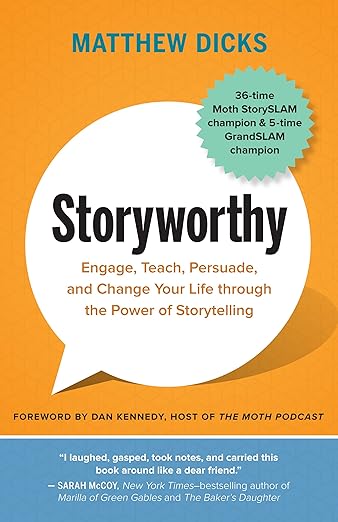Summary Sentence: A moving story is designed to convey a single moment in time (climax), it shows a transformation of a character (arc), and keeps the audience engaged through techniques like stakes and surprise.
Review: This book reveal’s StorySlam champion Mathew Dick’s tips and tricks for crafting compelling stories. Each chapter has a main point that’s illustrated with actionable advice and lots of stories. I was entertained and informed.
Other Resources: Amazon | Goodreads
- Homework for Life – storyworthy moments are often short events (moments of realization and big change). Everyday write down a storyworthy moment from the day to create a database of potential stories
- Story Arc – there must be a transformation. Start as one thing and end as another.
- Topic: Great stories are about a single short “five-second moment” (realization, revelation, idea, big event, everything changes, etc.). The entire purpose of your story is to convey that single moment.
- Connect with your audience. You want your story to be relatable, understandable, and comprehensible
- Failure Stories > Success Stories
- Things going wrong is more entertaining. Success is hearing someone brag about themselves.
- When you DO tell a success story you should undermine yourself and your success. Reveal your flaws and mistakes before telling of something great you did.
- Ending: The “five-second moment” is what your story builds to. It comes at the end of your story.
- Beginning: The beginning of your story should be the exact opposite of the ending. So you should start by conveying the opposite of the “five-second moment”.
- Start with movement – you want the audience to feel like they’re already moving (ideally physically moving).
- Don’t set expectations at the beginning or give thesis statements. This ruins surprise and the expectations may not be met.
- Middle
- Stakes help your audience keep listening.
- Elephant – Tell the audience the reason to listen early on
- Backpacks – Express the hopes, fears, plans before continuing the story
- Breadcrumbs – Hint at what will happen next, but don’t explicitly state it
- Hourglasses – Drag things out right before you reach a payoff
- Crystal Ball – A false prediction about something
- Question to ask: Would people care if I stopped speaking now?
- Use “But” and “Therefore”, instead of “and” to connect scenes/ideas. But/therefore keep movement and causation. (but, therefore, instead, except, because, so, as a result)
- You should create a movie in your audience’s mind.
- Try to provide a physical location for every scene
- Don’t ask rhetorical questions. Don’t address the audience. (this breaks the movie)
- Describe sensory information of the scene
- Use the present tense to emphasize important parts and bring the audience into the present moment with you
- Surprise – Surprise is the only tool you have to create emotional reactions. Create unexpected moments.
- Provide evidence first and then sometimes give the thesis/summary/payoff.
- Create contrast between the surprise and the moment leading up to the surprise
- Plant bombs – Hide important information to make it seem unimportant, then it will be surprising when it comes up later. You don’t want the audience to see the payoff coming because the information was obviously important.
- Humor (stories don’t need humor, but it’s a great tool)
- Start with a laugh – try to make them laugh within the first 30 seconds
- Laugh before negative emotions – contrast helps make great stories
- Laugh after intense parts – helps reset the audience
- Do NOT end on a laugh – you want the audience to end thinking about the five second moment, not something funny you said.
- Stakes help your audience keep listening.
- Topic: Great stories are about a single short “five-second moment” (realization, revelation, idea, big event, everything changes, etc.). The entire purpose of your story is to convey that single moment.
- Your story should be as short as possible. Cut everything out that isn’t needed, strategic, or purposeful.
- “Dinner Test” – speak as if you’re talking to a friend at dinner. A story is not theater or poetry. You should sound authentic.
- The negative – stating a thing is not something is better than stating it is something because it makes people think about the other thing too (not strong → strong)
- Ideally your audience will experience a range of emotions
- Avoid being vulgar and swearing too much
- Pop culture / celebrity references are risky because people might not know who they are
- Every lesson needs a hook (a reason to learn) – something “entertaining, engaging, through-provoking, surprising, challenging, daring, and even shocking.”
